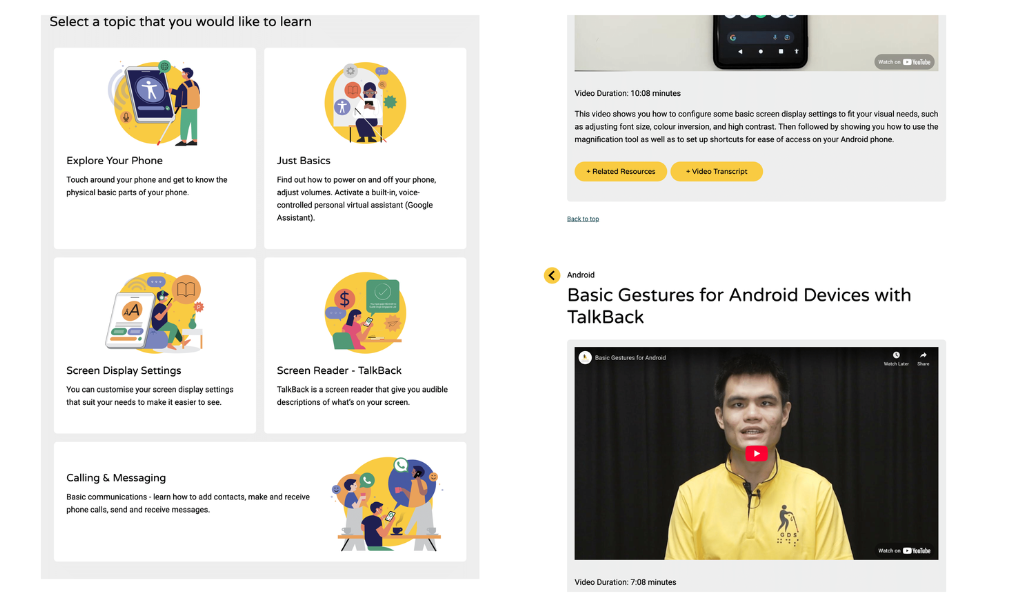
AsianScientist (Apr. 07, 2025) – The ubiquitous smartphones have become necessary for important activities like transacting and banking. Some functions for these activities, such as two-factor authentication systems, do not normally pose much difficulty to the average person, but they can be perplexing and nearly impossible to navigate for certain demographics, such as the elderly and persons with visual impairment (PVI).
All smartphones have accessibility features that can turn them into assistive technology devices for PVIs, but many PVIs may not necessarily know how to optimize these functions. In an online survey of 68 PVIs based in Singapore and Australia, a large majority indicated that they trained themselves in using assistive technology with online materials. This may make learning less effective, according to Assistant Professor Tan Hwei Lan, who conducts research in assistive technology at the Singapore Institute of Technology (SIT).
“There are lots of internet resources available now, such as videos and blogs, that teach people with vision impairment how to use a smartphone with low vision accessibility features,” she said. “However, the problem is that there are just too many good resources, and you would have to sieve through many of them to find what you are looking for.”
More is certainly not better. In addition to the overwhelming wealth of resources that one would need to make sense of, Assistant Professor Tan explained that there is a research gap in understanding how training can be better done. There are studies actively looking into developing accessible apps and making smartphone designs more accessible, but literature on ‘soft technology’—which refers to assessments and training that support the use of ‘hard technology’ like accessible apps—is sparse.
Motivated to uncover the best practices for helping PVIs learn how to use low vision accessibility features in smartphones, Assistant Professor Tan decided to make it the focus of her PhD project. The result? A toolkit that serves as a learning resource to help PVIs, trainers and the family members of PVIs in using assistive technology on their smartphones.

The project, funded by the Singapore Infocomm Media Development Authority Digital for Life fund (IMDA DFL), was accomplished in three phases. The first was the survey phase that examined existing research on training PVIs. The second was the data-gathering phase, where trainers and learners of assistive technology were surveyed on their learning experiences and wish lists for future training. Last was the co-design phase, which involved trainers and learners at Guide Dog Singapore (GDS) in the creation and curation of the toolkit’s content.
“What differentiates the toolkit from other internet resources would be the effort that went into producing this evidence-informed toolkit, and its ground-up approach that involved the trainers and learners,” explained Assistant Professor Tan.
Rather than relying solely on personal experiences, the toolkit’s design was based on carefully evaluated data and research, which is the first of its kind in the world. Some notable features in the toolkit had been suggested by the co-designers from GDS, and one of these is the inclusion of videos.
“When I first started conceptualizing this web-based toolkit, I didn’t factor in videos,” said Assistant Professor Tan, who later heeded the recommendations of her GDS co-designers for two reasons.
First, videos have audio instructions, and PVIs can rely on these auditory instructions to follow along. Second, some PVIs with limited vision can still rely on the visuals to help them learn. Having incorporated this feedback, the toolkit now includes a library of videos written and filmed by the co-designers. The team also added helpful content on the website, such as a section that addresses questions on increasing the font size on different models of smartphones.

Additionally, Assistant Professor Tan sought feedback from social service agencies, such as active aging centers, that may promote using the toolkit in the communities they serve. One key concern raised was the low English proficiency of members in these communities. Moving forward, the team aims to translate the toolkit into vernacular languages like Chinese, which would help serve a bigger population in Singapore.
The toolkit has already made waves among the PVI community, not just for its usefulness but also for its co-design approach. According to Assistant Professor Tan, one of her participants remarked that they often were unsure if their opinions carried any weight when they participated in research. It was undoubtedly good news to know that their suggestions have been incorporated into the toolkit’s development.
“There’s a sense of pride that we co-created this [toolkit] together. It is also enabling for the participants involved,” said Assistant Professor Tan.
The toolkit is just one step forward in Assistant Professor Tan’s dream of shaping an inclusive healthcare for the future. To achieve a digitally inclusive society, she finds it essential for different sectors and stakeholders to come together and work towards this shared goal. To that end, she is now working on a similar co-design approach to develop a program promoting physical activity participation for physically disabled persons.
For more information on the toolkit, contact Assistant Professor Tan Hwei Lan here.
—
Source: SIT
Disclaimer: This article does not necessarily reflect the views of AsianScientist or its staff.

